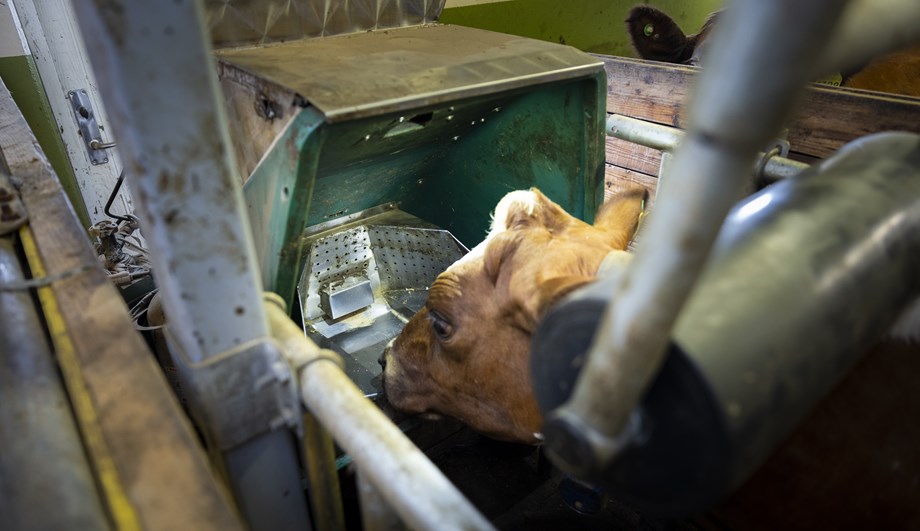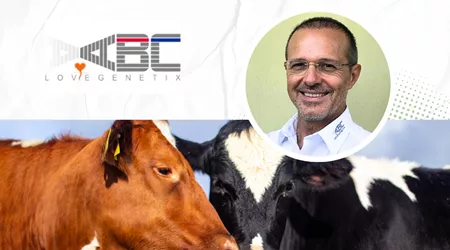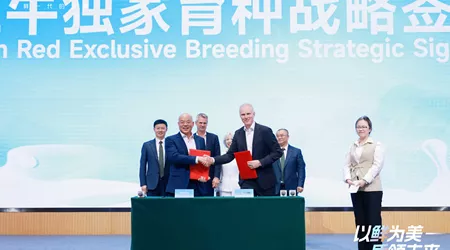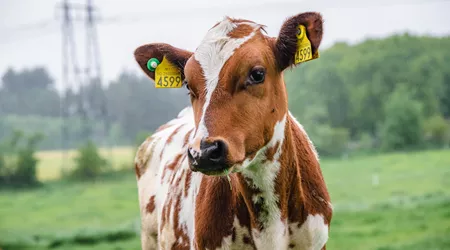Article by: Eli Hveem Krogsti, Sustainability and Green Project Manager, Geno SA & Norwegian Red
Emphasizing Sustainability
The balanced breeding program for Norwegian Red (NR) is defined through more than 40 traits. This is a population with high genetic variation. With this unique position, Geno has been able to develop a sustainable dairy breed with a dual purpose.
In 2019, The Agriculture Climate Plan was adopted in Norway, and the aim was to reduce the total emission of greenhouse gases from agriculture by 5 million CO2 equivalents by 2030. The annual genetic gain for NR, estimated at 2.5 percent, is an important contribution to this work. In addition, the investment towards breeding a more feed-efficient cow with reduced emissions of methane will make a further positive contribution.
Genetic variation
Since 2019, Geno has registered methane emissions from dairy cows in 16 herds in Norway. Based on this data material, Geno has been able to calculate the heritability of methane emissions from NR. The estimated heritability of 0.34 implies that 34 percent of the variation for the trait is due to genetics. This is good news for the further development of an index for methane emissions for NR.
A more feed-efficient Norwegian Red cow
Another element that is important for the overall sustainability of milk production is the feed quality and the animals' ability to utilize the forage. In 2021 Geno therefore installed equipment to record individual roughage feed intake in 14 commercial herds. The goal in the long term is to be able to select feed efficiency at NR. Geno receives daily information from these herds participating in the project.
In these herds, we have fitted feed mangers with weight cells along the entire feed tray so that the cows only have access to roughage in these mangers. The cows must have free access to roughage, and the participating herds must basically run a similar feed regime as they have done in the past. Samples from the roughage are collected weekly and analyzed for nutrient contents.
Accurate registrations
In order to get good measurements of how much each individual cow eats, the feed mangers are connected to antennas that read the cows' electronic ear tags. When an ear tag is registered, an air-operated gate lowers and gives the cow access to the feed in the manger. The difference in weight between feed in the manger before and after the visit forms the basis for recorded feed intake per visit. A log is generated and first sent to a farm computer. Data is then sent to Geno via a cloud solution.
In addition to an exact measurement of the cow's feed intake every day, we also get useful information about the animal's eating behavior - how often they visit the feed mangers and how much they eat per visit.
Large variation
The results show that there is a large variation in daily forage intake between individual cows. This can be influenced by conditions such as feed quality, animal flow, how often you feed, lactation number, and lactation stage. We record environmental factors so we can correct these in genetic analyses. Preliminary calculations show that around 20 percent of the variation in dry matter intake is due to genetics. This is considered a medium-high heritability.
Detailed information on total feed ration
In addition to roughage intake, daily concentrate intake is recorded at the individual level.
To find exact nutritional and energy values from the proportion of concentrate in the feed ration, the type of concentrate is linked to an application with nutritional content for all types of concentrate used. In this way, we can find out how much nutrition and energy the cow gets from the concentrate versus the forage she eats and assess the cow's potential as a forage utiliser.
Properties with high complexity
Feed efficiency is a complex trait that, in addition to direct feed intake, involves several other elements that have to be considered. That is why, among other things, body weight is recorded every time the cows visit the milking robot. Daily milk yield is recorded in the milking robot every day. This information flows into Geno's database together with concentrate intake. The herds participating in the project also take milk samples every month so that we get information on the content of the milk per individual cow. When this information is combined with feed utilization and body weight development, we have a good basis for assessing how feed-efficient each cow is.
Connection with other characteristics
In a balanced and sustainable breeding goal, we need to consider all important traits in relation to each other. If a characteristic has an undesirable genetic association with another characteristic, this must be considered in the construction of the total merit index. In short, as expected, high dry matter intake has a positive correlation with kg milk, kg protein, and kg fat. In addition, dry matter intake also shows associations with certain exterior characteristics related to body size, such as dairy type, stature, rump width, and body depth.
This knowledge becomes part of the overall assessment when dry matter intake, as one of the sub-characteristics of feed efficiency, is to be weighted into the breeding target.
Registration of methane emissions and feed intake at the same time
During 2023, all the herds participating in the feed efficiency project will have a Greenfeed (methane meter) installed. The units are moved from the farms that participated in the methane project. The producers who have contributed here have allowed us to record good-quality data for methane emissions. We have found out how much the NR cow emits on average per day (approx. 420 grams/day), as well as the variation in emissions per individual. The amount of methane emissions per day is closely related to the lactation curve, which is expected.
Now we want to go one step further and link methane emissions with daily records for milk yield, forage intake, forage quality, and weight development. The results we then obtain can be used in a balanced breeding goal for NR with an extended sustainability profile.



